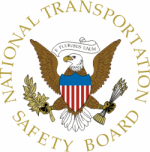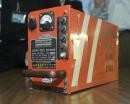American Removed As A Party To The Investigation Over Data
Recorder Protocol
 In its continuing investigation of
the runway overrun of a jetliner in Jackson Hole, WY, the NTSB has
developed the following factual information:
In its continuing investigation of
the runway overrun of a jetliner in Jackson Hole, WY, the NTSB has
developed the following factual information:
At about 1138 MST on Wednesday,
December 29, American Airlines flight 2253, a B-757-200 (N668AA)
inbound from Chicago O'Hare International Airport, ran off the end
of runway 19 in snowy conditions while landing at Jackson Hole
Airport. No injuries were reported among the 181 passengers and
crew on board.
The aircraft came to rest in hard
packed snow about 350 feet beyond the runway overrun area. An
initial inspection did not reveal any structural damage to the
aircraft. Shortly after the aircraft came to a stop, in accordance
with American Airlines' procedures, the pilots pulled the circuit
breaker to the cockpit voice recorder (CVR) to preserve all of the
recorded information for investigators.
The CVR and DFDR (digital flight
data recorder) arrived at the Safety Board's recorder laboratory on
Thursday evening, Dec. 30, where investigators were standing by to
download the contents of both recorders. The CVR provided a
two-hour recording of excellent quality audio; the voices of each
of the pilots on the flight deck were clearly audible. The DFDR
provided 1200 recorded parameters of flight data and captured the
entire incident.
The crew, who were interviewed on
Thursday evening, indicated that they saw the runway prior to
reaching the minimum descent altitude before touchdown. Both
crewmembers characterized the flight and approach to landing as
uneventful prior to the runway overrun. The first officer was the
flying pilot.
 But American has been removed as a
party to the investigation because of a breech of protocol in
dealing with the aircraft's Flight Data recorder. The Safety Board
has long-established protocols for the handling and transportation
of CVRs and DFDRs that contain recorded information from a
commercial aviation incident, which by definition is one where no
serious injuries or substantial damage to the aircraft or other
property has occurred.
But American has been removed as a
party to the investigation because of a breech of protocol in
dealing with the aircraft's Flight Data recorder. The Safety Board
has long-established protocols for the handling and transportation
of CVRs and DFDRs that contain recorded information from a
commercial aviation incident, which by definition is one where no
serious injuries or substantial damage to the aircraft or other
property has occurred.
In such incident investigations, the Safety Board frequently
asks the airline involved to transport the recorders on their own
aircraft as such an arrangement often provides the most expeditious
means of conveying the devices to Safety Board labs in Washington.
The airline is instructed to transport the recorders without delay
and without accessing the information contained within them by any
means. This practice has worked efficiently and without
complication for more than 40 years.
During this incident investigation, the Safety Board learned
that the recorders were flown to Tulsa, OK, where American Airlines
technicians downloaded information from the DFDR; the CVR was not
accessed by American. "Although a thorough examination by our
investigators determined that no information from the DFDR was
missing or altered in any way, the breach of protocol by American
Airlines personnel violates the Safety Board's standards of conduct
for any organization granted party status in an NTSB
investigation," said NTSB Chairman Deborah A.P. Hersman. "Because
maintaining and enforcing strict investigative protocols and
procedures is vital to the integrity of our investigative
processes, we have revoked the party status of American Airlines
and excused them from further participation in this incident
investigation."
American Airlines has assured the Safety Board that a full
review of proper procedures and internal controls would be
undertaken to ensure that such an occurrence is not repeated.
Despite their removal from party standing, the NTSB will provide
American Airlines with any and all information
needed to ensure a timely response to operational safety
deficiencies identified in the course of the investigation.

Cockpit Voice Recorder
The accident docket, which will contain additional factual
information, is expected to be opened in 60-90 days. It will be
available on the docket section of the NTSB website.
 Aero-News: Quote of the Day (04.28.25)
Aero-News: Quote of the Day (04.28.25) ANN's Daily Aero-Term (04.28.25): Decision Altitude (DA)
ANN's Daily Aero-Term (04.28.25): Decision Altitude (DA) ANN's Daily Aero-Linx (04.28.25)
ANN's Daily Aero-Linx (04.28.25) Airborne-Flight Training 04.24.25: GA Refocused, Seminole/Epic, WestJet v TFWP
Airborne-Flight Training 04.24.25: GA Refocused, Seminole/Epic, WestJet v TFWP Aero-News: Quote of the Day (04.29.25)
Aero-News: Quote of the Day (04.29.25)





